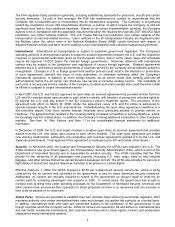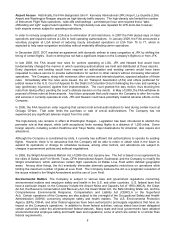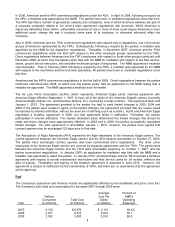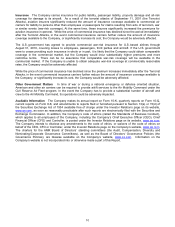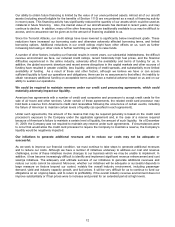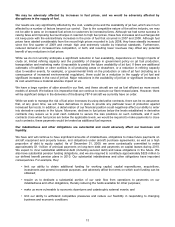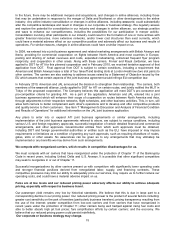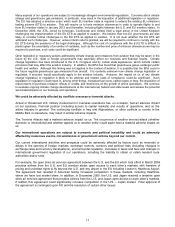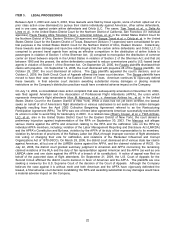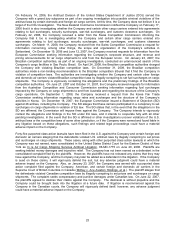American Airlines 2009 Annual Report Download - page 18
Download and view the complete annual report
Please find page 18 of the 2009 American Airlines annual report below. You can navigate through the pages in the report by either clicking on the pages listed below, or by using the keyword search tool below to find specific information within the annual report.
15
In the future, there may be additional mergers and acquisitions, and changes in airline alliances, including those
that may be undertaken in response to the merger of Delta and Northwest or other developments in the airline
industry. Any airline industry consolidation or changes in airline alliances, including oneworld, could substantially
alter the competitive landscape and result in changes in our corporate or business strategy. We regularly assess
and explore the potential for consolidation in our industry and changes in airline alliances, our strategic position
and ways to enhance our competitiveness, including the possibilities for our participation in merger activity.
Consolidation involving other participants in our industry could result in the formation of one or more airlines with
greater financial resources, more extensive networks, and/or lower cost structures than exist currently, which
could have a material adverse effect on our competitive position and adversely affect our business and results of
operations. For similar reasons, changes in airline alliances could have a similar impact on us.
In 2008, we entered into a joint business agreement and related marketing arrangements with British Airways and
Iberia, providing for commercial cooperation on flights between North America and most countries in Europe,
pooling and sharing of certain revenues and costs, expanded codesharing, enhanced frequent flyer program
reciprocity, and cooperation in other areas. Along with these carriers, Finnair and Royal Jordanian, we have
applied to DOT for ATI for this planned cooperation and in February 2010, we received tentative approval of that
application from DOT. Final approval from DOT is subject to certain conditions, including a requirement that
American and British Airways lease a total of four takeoff and landing slots at London Heathrow (two slot pairs) to
other carriers. The carriers are also seeking to address issues raised by a Statement of Objection issued by the
EU which asserts that certain aspects of the joint business agreement would infringe EU competition law.
In February 2010, American and JAL announced the decision to strengthen their relationship. The carriers, both
members of the oneworld alliance, jointly applied to DOT for ATI on certain routes, and jointly notified the MLIT in
Tokyo of the proposed cooperation. The Company believes this application will meet DOT’s pro-consumer and
pro-competition criteria for granting ATI. As a part of the application, American and JAL entered into a joint
business agreement which will enhance their scope of cooperation on routes between North America and Asia,
through adjustments to their respective networks, flight schedules, and other business activities. This, in turn, will
allow both carriers to better complement each other’s operations and to develop and offer competitive products
and quality service to their customers. See Item 7 ―Management’s Discussion and Analysis of Financial Condition
and Results of Operations‖ for additional information on the JAL joint business application.
Any plans to enter into or expand ATI joint business agreements or similar arrangements, including
implementation of the joint business agreements referred to above, are subject to various conditions, including
various U.S. and foreign regulatory approvals, successful negotiation of certain detailed financial and commercial
arrangements, and other approvals. Governmental entities from which such approvals must be obtained,
including DOT and foreign governmental authorities or entities such as the EU, have imposed or may impose
requirements or limitations as a condition of granting any such approvals, such as requiring divestiture of routes,
gates, slots or other assets. No assurances can be given as to any arrangements that may ultimately be
implemented or any benefits we may derive from such arrangements.
We compete with reorganized carriers, which results in competitive disadvantages for us.
We must compete with air carriers that have reorganized under the protection of Chapter 11 of the Bankruptcy
Code in recent years, including United, Delta and U.S. Airways. It is possible that other significant competitors
may seek to reorganize in or out of Chapter 11.
Successful reorganizations by other carriers present us with competitors with significantly lower operating costs
and stronger financial positions derived from renegotiated labor, supply, and financing contracts. These
competitive pressures may limit our ability to adequately price our services, may require us to further reduce our
operating costs, and could have a material adverse impact on us.
Fares are at low levels and our reduced pricing power adversely affects our ability to achieve adequate
pricing, especially with respect to business travel.
Our passenger yield remains very low by historical standards. We believe that this is due in large part to a
corresponding decline in our pricing power. Our reduced pricing power is the product of several factors including:
greater cost sensitivity on the part of travelers (particularly business travelers); pricing transparency resulting from
the use of the internet; greater competition from low-cost carriers and from carriers that have reorganized in
recent years under the protection of Chapter 11; other carriers being well hedged against rising fuel costs and
able to better absorb high jet fuel prices; fare simplification efforts by certain carriers; and the economy. We
believe that our reduced pricing power could persist indefinitely.
Our corporate or business strategy may change.


